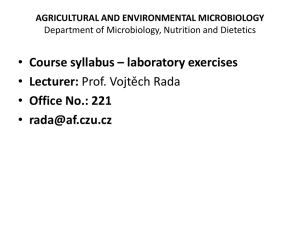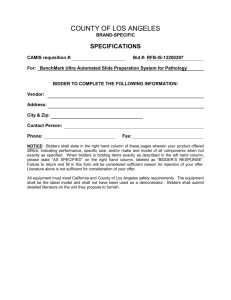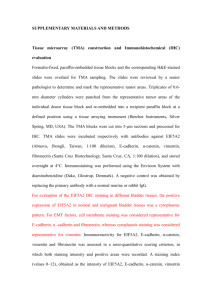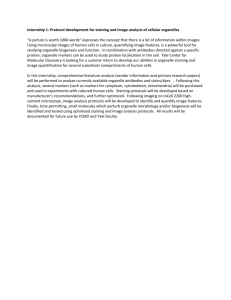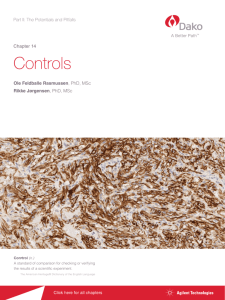Controls
advertisement
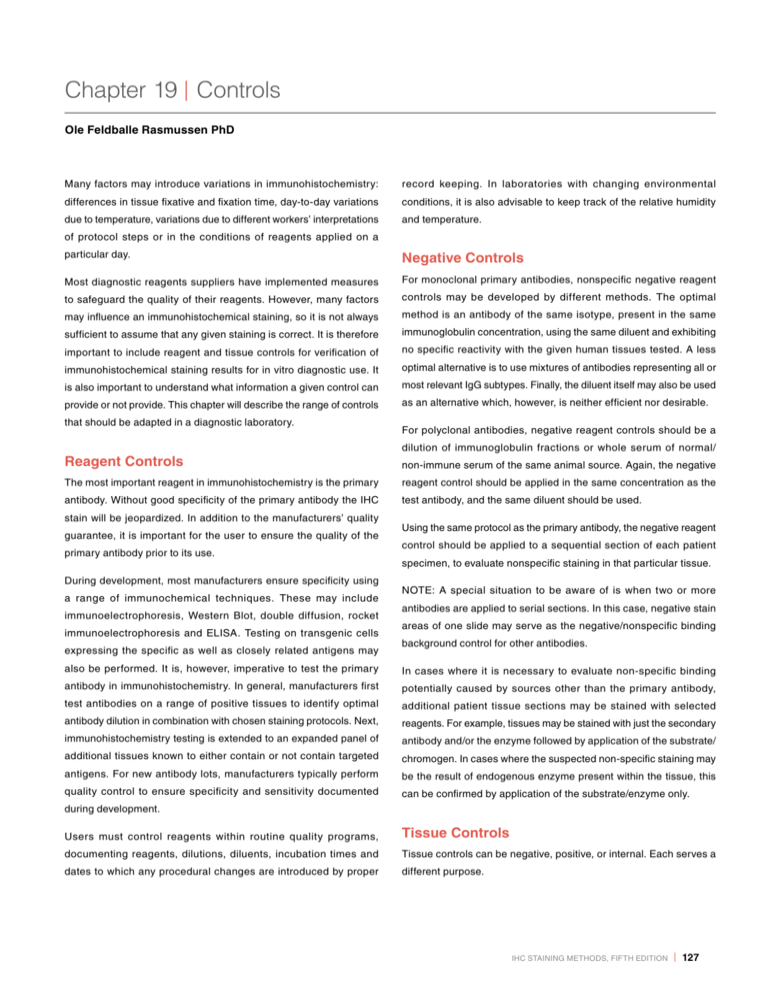
Chapter 19 | Controls Ole Feldballe Rasmussen PhD Many factors may introduce variations in immunohistochemistry: record keeping. In laboratories with changing environmental differences in tissue fixative and fixation time, day-to-day variations conditions, it is also advisable to keep track of the relative humidity due to temperature, variations due to different workers’ interpretations and temperature. of protocol steps or in the conditions of reagents applied on a particular day. Negative Controls Most diagnostic reagents suppliers have implemented measures For monoclonal primary antibodies, nonspecific negative reagent to safeguard the quality of their reagents. However, many factors controls may be developed by different methods. The optimal may influence an immunohistochemical staining, so it is not always method is an antibody of the same isotype, present in the same sufficient to assume that any given staining is correct. It is therefore immunoglobulin concentration, using the same diluent and exhibiting important to include reagent and tissue controls for verification of no specific reactivity with the given human tissues tested. A less immunohistochemical staining results for in vitro diagnostic use. It optimal alternative is to use mixtures of antibodies representing all or is also important to understand what information a given control can most relevant IgG subtypes. Finally, the diluent itself may also be used provide or not provide. This chapter will describe the range of controls as an alternative which, however, is neither efficient nor desirable. that should be adapted in a diagnostic laboratory. Reagent Controls For polyclonal antibodies, negative reagent controls should be a dilution of immunoglobulin fractions or whole serum of normal/ non-immune serum of the same animal source. Again, the negative The most important reagent in immunohistochemistry is the primary reagent control should be applied in the same concentration as the antibody. Without good specificity of the primary antibody the IHC test antibody, and the same diluent should be used. stain will be jeopardized. In addition to the manufacturers’ quality guarantee, it is important for the user to ensure the quality of the primary antibody prior to its use. During development, most manufacturers ensure specificity using a range of immunochemical techniques. These may include immunoelectrophoresis, Western Blot, double diffusion, rocket immunoelectrophoresis and ELISA. Testing on transgenic cells expressing the specific as well as closely related antigens may Using the same protocol as the primary antibody, the negative reagent control should be applied to a sequential section of each patient specimen, to evaluate nonspecific staining in that particular tissue. NOTE: A special situation to be aware of is when two or more antibodies are applied to serial sections. In this case, negative stain areas of one slide may serve as the negative/nonspecific binding background control for other antibodies. also be performed. It is, however, imperative to test the primary In cases where it is necessary to evaluate non-specific binding antibody in immunohistochemistry. In general, manufacturers first potentially caused by sources other than the primary antibody, test antibodies on a range of positive tissues to identify optimal additional patient tissue sections may be stained with selected antibody dilution in combination with chosen staining protocols. Next, reagents. For example, tissues may be stained with just the secondary immunohistochemistry testing is extended to an expanded panel of antibody and/or the enzyme followed by application of the substrate/ additional tissues known to either contain or not contain targeted chromogen. In cases where the suspected non-specific staining may antigens. For new antibody lots, manufacturers typically perform be the result of endogenous enzyme present within the tissue, this quality control to ensure specificity and sensitivity documented can be confirmed by application of the substrate/enzyme only. during development. Users must control reagents within routine quality programs, Tissue Controls documenting reagents, dilutions, diluents, incubation times and Tissue controls can be negative, positive, or internal. Each serves a dates to which any procedural changes are introduced by proper different purpose. IHC Staining Methods, Fifth Edition | 127 Controls Positive Tissue Controls have been treated exactly as the positive control. One example of a These are indicative of proper staining techniques and provide a “built-in” control is the presence of S-100 protein in both melanoma and measure of whether the target retrieval procedure has been carried normal tissue such as peripheral nerves and dendritic reticulum cells. out correctly. They should assess correct temperature and incubation Other examples include vimentin which is distributed ubiquitously, and period of water baths or other retrieval methods. Likewise, positive desmin which is present in blood vessel musculature. tissue controls verify that all reagents were applied, that they performed correctly, and the proper incubation time and temperature were used. Negative Tissue Controls Positive staining of negative controls could indicate a lack of specificity These controls are also indicative of properly prepared tissue. To be of the antibody or nonspecific background staining. Just as in positive as accurate as possible, positive tissue controls should be prepared controls, tissue used for negative controls should be prepared in the in the same manner as patient samples. Optimally autopsy/biopsy/ same manner as the patient sample. Additionally, the selected tissue surgical specimens should be fixed, processed and embedded as should not contain the specific antigen to be tested. One example soon as possible for best preservation of antigens. Please see the would be use of normal liver tissue s as a control for hepatitis B section, Processing Control Indicator below. surface antigen, or a HER2/neu-negative tissue for testing with Dako HercepTest™ Kit. One positive tissue control should be included for each set of tests. Ideally this control should contain a spectrum of weak to strongly positive If positive staining occurs in the negative tissue control, consider test reactivity. If such tissue is not available, another option is to select specimen results invalid. a weakly positive tissue, as this provides the best basis to evaluate whether a particular staining reaction is too weak or too strong. During a staining run, positive tissue controls may be run on a separate slide, or included on the same slide as the test specimen. If this second option is chosen, one method is to use small arrays with selected tissue or cell lines to serve as a positive control for a range of stains. In this method, one tissue may serve as a positive control, a different tissue may serve as a negative control (see below). Processing Control Indicator There is currently no optimal way to evaluate whether tissue processing has occurred satisfactorily. Battifora (1) has suggested using vimentin, a substance present in virtually every tissue specimen. Furthermore, the vimentin V9 clone recognizes an epitope that is partially susceptible to fixation with formaldehyde and can function as a “reporter” for the quality of fixation. Proper processing should give uniform distribution of vimentin reactivity in tissue vessels If positive tissue controls do not perform as expected, results, from and stromal cells. Good, uniform vimentin staining demonstrates test specimens should be considered invalid. adequate fixation, while heterogeneous staining indicates variable Positive controls cut and stored in bulk with cut surfaces exposed for extended periods should be tested to determine if the antigens are stable under these storage conditions. Internal Tissue Controls Internal controls, also known as “built-in” or intrinsic controls, contain the target antigen within normal tissue elements, in addition to the tissue elements to be evaluated. Thus, they can replace external positive controls. This is ideal, as the tissue elements to be evaluated 128 | IHC Staining Methods, Fifth Edition and sub-optimal fixation. In these cases only fields demonstrating the best staining intensity and homogeneity should be used in the patient sample analysis. Cell Line Controls Several FDA-approved predictive IHC assays contain cell line controls as part of the diagnostic kit or are sold separately. These are specifically developed to monitor staining of the antigen of interest, and should be included in all stain runs as an additional protocol control. Controls Just as with tissue controls, cell line controls may be positive or not contain cell line controls because they include probes against both negative. Positive cell line controls monitor staining performance the target gene and the respective centromere, in order to evaluate by assessing target retrieval, blocking, antibody incubation and the amplification ratio (or deletion) of the target gene. In this way, the visualization. Negative cell line controls assess specificity and, centromere probe also serves as internal control. depending on the characteristics of the chosen cell line, may also provide information on performance. Control Programs An ideal negative cell line control will contain an amount of target Immunohistochemical stain test results have no common quantitative antigen, sufficiently low to produce no staining if the procedure has been measures. Instead, results are typically based on subjective performed correctly. At the same time, the amount should be sufficiently interpretation by microscopists of varying experience (2-4). Quality high to produce a weakly positive stain if the run has been performed control and assurance therefore remain crucial, and need high under conditions that produce an excessively strong stain. attention by both manufacturers and laboratory users. An ideal positive cell line control would contain a number of target A number of scientific bodies have quality programs or quality antigens producing staining of medium intensity. This would allow assessment services. These programs should be seen as an aid or the control to assess both stains that are too weak and stains that external assistance and should never replace national requirements are too strong. for internal quality control. An example of the way in which cell line controls can be used is One highly regarded program is the non-profit United Kingdom National illustrated by Dako’s HercepTest™ kit, which contains three cell line External Quality Assessment Service (UK NEQAS), established in controls: a negative, a 1+ (weak staining) and a 3+ (strong staining). 1995 to “advance education and promote the presentation of good All are designed to be placed on the same microscope slide. health by providing external quality assessment services for clinical laboratories.” UK NEQAS includes a range of specific external quality Figure 1 below shows examples of staining HercepTest™ control cells. assessment (EQA) services, each focusing on areas such as breast Fluorescent in situ hybridization kits such as HER2 FISH pharmDx™ do screening pathology. Negative Cell Line 1+ Cell Line 3+ Cell Line Figure 1. Cell line controls for Dako HercepTestTM. IHC Staining Methods, Fifth Edition | 129 Controls Likewise, in the United States the College of American Pathologists References (CAP) provides a similar proficiency testing service for its 1. Battifora H. Am J Clin Pathol 1991;96:669-71. member laboratories. 2.Taylor CR. Applied Immunohistochem 1993;1:232-43. 3.Elias JM et al. Am J Clin Pathol 1989;92:836-43. Also the external quality assessment program run by Nordic Immunohistochemical Quality Control (NordiQC), established in 2003, should be mentioned. It now has more than 100 laboratories participating. Each organization provides proficiency testing in IHC for participating laboratories by sending out tissue samples to be included as part of a laboratory’s routine IHC staining procedures. Laboratories then return their results, which are compared with all other participating laboratories and summarized in a final report. Contact information for CAP can be found at the Web site, www.cap. org, for UK NEQAS at the Web site, www.ukneqas.org.uk, and for NordiQC at the Web site, www.nordiqc.org. Future Aspects To ensure quality diagnosis, immunohistochemistry quality control will become even more important. It is expected that the next five years will see increased participation in proficiency testing, as an increase in the number of laboratories that become accredited. New technologies on the horizon will also likely facilitate more efficient means of quality control. 130 | IHC Staining Methods, Fifth Edition 4.Taylor CR. Arch Pathol Lab Med 2000;124:945-51.


